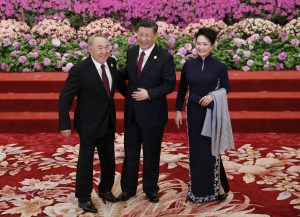Since its 2013 launch, China’s Belt and Road Initiative has become Beijing’s flagship foreign policy initiative. Sometimes it seems that all things are BRI and BRI is all things.
As the authors of a new report on Chinese public diplomacy writ large note, “Beijing’s diplomacy… dwarfs its other public diplomacy tools in terms of sheer scale and visibility.”
The BRI instigated a growth in the volume of financial diplomacy — encompassing infrastructure projects, budget support, debt relief and humanitarian assistance — particularly in South and Central Asia. Chinese funding of development projects pre-dates the initiative, of course, and increased sharply as early as 2008.
In a new report, titled Silk Road Diplomacy: Deconstructing Beijing’s toolkit to influence South and Central Asia, a group of scholars at William & Mary’s AidData research lab, supported by the U.S. State Department and in partnership with the Asia Society Policy Institute and the China Power Project of the Center for Strategic and International Studies (CSIS), analyze a mountain of data regarding Chinese public diplomacy since 2000, “to illuminate which tools Beijing deploys, with whom, and to what effects in the SCA region.”
The report is worth diving into in full, but I want to highlight a few specifics that were particularly interesting regarding Chinese financial diplomacy and Kazakhstan. Financial diplomacy, with BRI as its contemporary flagship, is an oversized aspect within China’s broader public diplomacy efforts. Several of the report’s major findings — for example, that “Beijing’s financial diplomacy is associated with a higher number of Chinese migrants and new Chinese firms” and that its financial diplomacy efforts “can incur a public backlash” — are not necessarily surprising. But they do help explain a cyclical and cynical pattern in which Beijing’s public diplomacy efforts, including financial diplomacy, are deployed “as a means to win over foreign publics and advance its national interests” but certain aspects, in certain countries, are counterproductive.
Kazakhstan is a prime example. China has directed more than a quarter of its financial diplomacy investments to Kazakhstan which has had its share of anti-Chinese protests. The report references both the 2016 land code protests and the 2019 protests. But these negative sentiments exist alongside positive perspectives on China as a partner, whether for infrastructure investment, educational and work opportunities, or trade.
Citizens in South and Central Asia more broadly, the report authors note, “hold more polarized views when it comes to Beijing’s financial diplomacy: these efforts are associated with both lower approval and disapproval of Chinese government leadership.” (emphasis mine). Put more simply, it appears that the more engaged China is in a given country, in both financial diplomacy terms and also with regard to elite visits, the more intense public attitudes.
The report cites studies that suggested that China allocated more of its financial diplomacy efforts to areas where public opinion about China, at baseline, is more favorable. “If this is the case,” the report authors write, “then financial diplomacy efforts may be diminishing and even reversing some of these favorable attitudes over time.”
Interestingly, the report notes that China has placed “a disproportionate emphasis on wooing two countries—Kazakhstan and Kyrgyzstan —with its exchange diplomacy in the form of sister cities and student scholarships.” Perhaps this is a counterweight to the negative attitudes generated by infrastructure projects, in part due to the abovementioned higher numbers of Chinese migrants and firms associated with Chinese financial diplomacy.
“Kazakhstan receives the greatest volume and diversity of Beijing’s public diplomacy activities out of the 12 SCA countries we examined,” the report notes. That volume and diversity is reflected in strong attitudes, as noted above: positive among elites courted by China and trending more negative among the general public. Interviewees, the report states, said this disconnect — success in bolstering support among political elites and lagging behind in “strengthing ties with the average Kazakh” — stems from “‘a fundamental misunderstanding of Kazakhstan in China,’ arguing that Beijing fails to anticipate and respond when decisions taken by political elites are seen by the public as benefiting Beijing at the expense of Kazakh people.”
Check out the full report here.

































